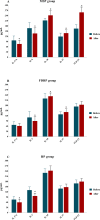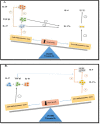The impact of vitamin D3 intake on inflammatory markers in multiple sclerosis patients and their first-degree relatives
- PMID: 32251441
- PMCID: PMC7135246
- DOI: 10.1371/journal.pone.0231145
The impact of vitamin D3 intake on inflammatory markers in multiple sclerosis patients and their first-degree relatives
Abstract
Background & aims: In our previous study, a Seesaw model was proposed for the fluctuation of crucial anti- (IL-10) and pro-inflammatory (Il-6 & IL-17A) cytokines through vitamin D3. In this paper, however, it is intended to extend the mentioned model by assessing the expression mRNA levels of IL-27 and TGF-β1 as well as the changes of plasma levels of IL-27, TGF-β1, IL-17A, IL-10, and IL-6 after treatment by vitamin D3.
Method: Venous blood samples were drawn from Healthy Participants (HP, n = 25) and First-Degree Relative Participants (FDRP, n = 25) as control groups and Multiple Sclerosis Participants (MSP, n = 25) before and after eight weeks of supplementation with 50000 IU vitamin D3. The mRNA expression and plasma concentrations were gauged by using Real-Time PCR and ELISA assay, respectively.
Results: The mRNA surfaces of IL-27, as well as TGF-β1, were up-regulated. However, the plasma levels of TGF-β1, IL-17A, and IL-6 were significantly different among the three groups. In addition, the plasma levels of IL-27, TGF-β1, IL-10, IL-17A, and IL-6 significantly changed following the administration of vitamin D3.
Conclusion: The findings of this paper illustrate that anti-inflammatory cytokines could have a key role in immunomodulatory functions due to their anti-inflammatory functions. To conclude, this might contribute to preventing the pathophysiological process of MS. Also, the proposed model could be used as a preventive way on disposed people to multiple sclerosis, particularly in first degree relatives of these patients.
Conflict of interest statement
The authors have declared that no competing interests exist.
Figures




References
Publication types
MeSH terms
Substances
LinkOut - more resources
Full Text Sources
Medical
Research Materials
Miscellaneous

